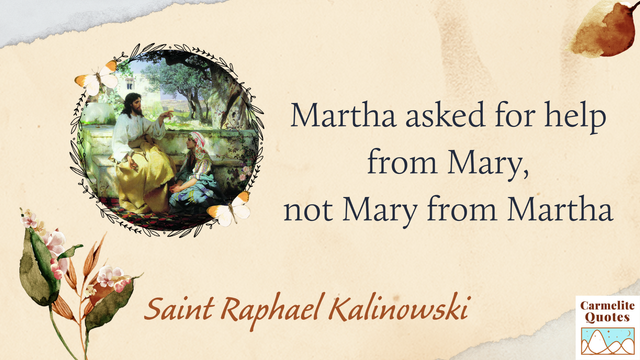We think of prayer as something we do for God whereas prayer is essentially a gift.
Prayer is intimacy with God and it is God who offers us this intimacy. We respond. There is only one Christian prayer and that is Jesus, the New and Eternal Covenant, the union in person of God and man. All Christian prayer is essentially through him, with him, and in him….
This God longs and longs to give, not just gifts, but himself; and it is only this supreme Gift that makes us utterly happy. We don’t have to bribe him with our good works or make ourselves desirable and “worthy.” His love makes us lovely.
The little story of Martha and Mary expresses the truth graphically (Cf. Lk 10:38–42).
What Jesus is saying is that, when he enters our house, that is, when we are in direct contact with him, then it is for him to give to us, to serve and feed us, not the other way round.
This, I believe, represents the reality of Christian existence: receiving God, All-Love, in Christ, letting God love us, nourish us, bring us to our total fulfillment. Well-nourished, we turn to our neighbors and share our nourishment with them. Freely we have received and freely we must give.
Sister Rachel Gregory, O.C.D. (Ruth Burrows)
Chapter 5, Receiving the Gift of God
Choose to Trust
Burrows, R & Jones, M 2019, Ruth Burrows: Essential Writings, Orbis Books, Maryknoll, New York.
Featured image: This oil on canvas painting of the Kitchen Scene with Christ in the House of Martha and Mary by the Spanish master Diego Velázquez (1599–1660) was probably painted in 1618, according to art historians and scholars at the National Gallery in London. Their gallery label provides fascinating detail concerning this artwork:
A maid pounds garlic in a mortar, and other ingredients lie scattered on the table: fish, eggs, a shrivelled red pepper and an earthenware jug probably containing olive oil. An older woman points towards her, as if giving her instructions or telling her off for working too hard, or she may be drawing our attention to the figures in the background.
The scene visible in the upper right is taken from the New Testament (Luke 10: 38–42). As Mary sits at Jesus’s feet, listening to him, her sister Martha complains that she should not be left to serve the food alone. Christ replies, ‘Mary has taken that good part, which shall not be taken away from her’. We view it through an opening, although it has also been read as a reflection in a mirror or a picture hung on the wall.
The figures in the foreground, dressed in contemporary costume, may be intended as a latter-day Martha and Mary.
Image credit: Art UK (Public domain)
https://carmelitequotes.blog/2024/07/28/ruth-marthmary/
#Christ #gift #love #nourishment #prayer #RuthBurrows #spiritualDirection #SrRachelGregoryOCD #StMartha #StMaryOfBethany
